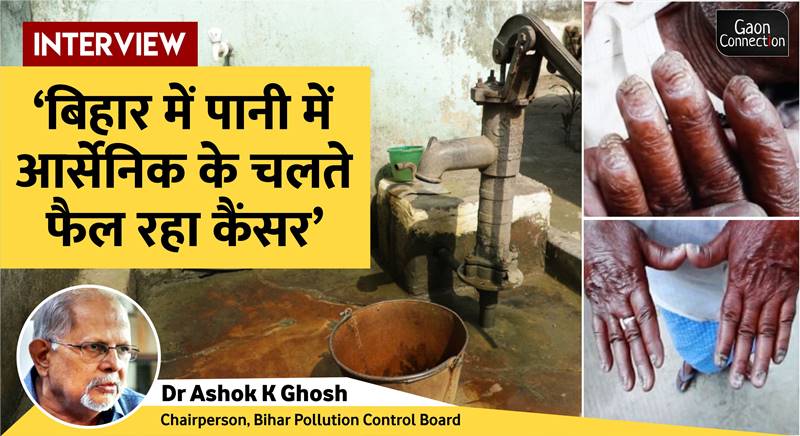Patna, Bihar
As of November 21, 2021, according to the Jal Jeevan Mission – Har Ghar Jal programme of the Government of India, Bihar sits pretty with 88.63 per cent of households having tap water supply. That is, of the 17,220,634 households in Bihar, 15,262,678 of them have tap connections.
However, there is rising concern over the contamination of groundwater in the state with dangerous pollutants, such as arsenic, iron and even uranium, which are far above permissible limits. While the World Health Organization has set the permissible limit of arsenic, a carcinogen, at 10 10 µg/litre, in Bihar the levels are much, much higher. And, a large chunk of rural population in arsenic affected districts of Bihar is forced to drink poison laced water.
In an interview with Gaon Connection, Ashok Kumar Ghosh, the scientist who is instrumental in finding arsenic in Bihar’s groundwater, says while rooting out the carcinogenic arsenic completely from the groundwater may not be possible, providing the population a supply of clean drinking water and a nourishing diet may go a long way in mitigating its adverse impact on health and wellbeing.
GC: You have worked for years in matters pertaining to groundwater contamination in Bihar. How serious is groundwater contamination in Bihar?
Dr Ghosh: When I began working on groundwater contamination in Bihar in 2003-2004, there was disbelief that the groundwater in the state had high arsenic content. The general opinion was that such contamination was present only in West Bengal and Bangladesh, and there were no studies to prove otherwise. But then, we began researching and conducting surveys with the support of UNICEF.
We first found high levels of arsenic in three districts in Bihar – Patna, Bhagalpur and Bhojpur – followed by Vaishali. We had a hard time convincing the government that there was arsenic contamination of the groundwater, but now the whole world accepts that Bihar has high amounts of arsenic in its ground water.
How serious is the arsenic contamination in the state?
We have so far tested approximately 46,000 hand pumps since 2004, and 30 per cent of those had arsenic higher than permissible limits.
We found the highest contamination in Buxar with 1,906 µg/l. Bhagalpur had 1,475 µg/l, 1860 µg/l in Bhojpur, while Patna had 960 µg/l. These were not in every pump we tested, but these were the highest readings.
Imagine what the impact of that is on human lives, when the World Health Organization says the permissible level is 10 µg/l.
Which are the districts in the state most affected by arsenic contamination?
Our research found that 18 of the 38 districts in the state are affected by arsenic in their groundwater, while the government figures pegged it at 12. The Central Ground Water Board said it was 12 districts only.
Also Read: 8.4 million rural households got tap water supply in 22 months: Jal Shakti Ministry
The highest prevalence of arsenic has been found in habitations on both the banks of the Ganges river, especially on its south banks, from Buxar to Bhagalpur where arsenic content in water is quite high. The Terai area also has high amounts of arsenic as well as areas in Supaul district and East Champaran.
Is arsenic, which is a known carcinogen, getting into human bodies? How serious is the health concern?
When I started research on the arsenic levels in groundwater, I was often asked what the symptoms were. At that time, the exposure of people to arsenic was still new. But, by the time I joined the Mahavir Cancer Centre in 2016, I saw many cancer patients and research confirmed that many of the cancers were linked to arsenic contamination.
More recently, we conducted a joint study as a part of an Indo-UK programme that came up with alarming findings.
In Bhagalpur, for example, we found that arsenic has entered the food chain through irrigation water. Potato, rice and wheat crops, which are most commonly consumed, contained elevated contents of arsenic. So, drinking water with high amounts of arsenic, and consuming food with elevated levels of arsenic will lead to an acute disease burden.
Where has the arsenic come from?
The source is from the Himalayas. There are lots of minerals there, among them is arsenopyrite, which is made up of iron and arsenic that is not water soluble. It is carried down by the waters from the mountains.
When the river meanders or changes its course, and people start living in those areas, the arsenopyrite is left behind and people are exposed to it. The arsenopyrite ostensibly lies dormant without visibly harming anyone, but it has an impact. But this was before the 1970s when people depended more on surface water from open wells etc., for their consumption.
But after the 70s, UNICEF, WHO, etc., conducted studies where they found bacterial infections from surface water sources caused high infant mortality due to diarrhoea in third world countries (India was considered third world then). They were encouraged to go for handpumps.
Soon handpumps became very popular. It was convenient, water was clean (arsenic is colourless, odourless and is not visible in the water) and easily accessed. Wells were abandoned and groundwater began to be overexploited, which has contributed to groundwater contamination with arsenic.
It is a thumb rule for us now. Wherever we detect high iron content, we know that chances of that area containing arsenic is high.
How does arsenic in the groundwater affect health?
Arsenic can wreak havoc on the human body. It can mess up the human body’s enzyme system and impact the DNA which in turn leads to skin conditions, digestive problems, liver malfunction on one side and on the other extreme lead to mental retardation and skill development issues in children and of course cancer.
We have found a direct correlation between arsenic and gall bladder cancer in the arsenic hotspots in the state. We are at the moment preparing a paper on it.
Also Read: ‘It is poison, not water, that comes out of the handpumps’
Is arsenic poisoning reversible?
If water is treated before consumption, if the nutrition of the people is taken care of with enough greens and antioxidants, it can be arrested. We have seen an improvement in skin conditions, etc., in villages where the surface water has been treated. Of course, it is important to realise that this is possible as long as the arsenic poisoning has not led to cancer, in which case reversing it is difficult.
What is the solution?
There is no complete solution. It is difficult to completely root out the problem of high arsenic. What can be done is to ensure safe drinking water to the population along with a nutritious diet. This could mitigate the severity of the impact. But it is an acute problem.
Can the arsenic be removed from the water sources?
We have to remove both iron and arsenic from the contaminated water. One has to remember that arsenic in the groundwater of Bihar is not due to factory pollutants or pesticides. It is a geogenic problem aggravated by anthropogenic activity (overexploitation of groundwater).
Had we used the water sources responsibly, continued using surface water and not switched entirely to groundwater, things may not have been so bad.
Has there been any headway in convincing people to go back to dugwell water?
Wherever we can, we have advised people to clean up their wells and use that water. We have found no traces of arsenic in open wells and surface water.
It is an uphill task. It is very difficult to convince people to go back to the laborious process of drawing water from a well when the alternative is water on demand from a handpump outside their homes.
When we tell them the well water is cleaner than the hand pump water, the elders in the village from the 60s and 70s, laugh at us. “When we used well water, you forced us to change to handpumps. Now you are lecturing us about going back to wells,” they ask.
Are there any awareness measures being taken?
We are doing reverse tracing at the cancer hospital. We get about 25,000 cancer patients a year at our hospital. When it is established that a patient has cancer and traces of arsenic is found in his blood, hair and nails, we test water in their village to see if it has high arsenic content.
There are many reasons for cancer, and we are still in the process of collecting data on how many of them are directly linked to arsenic.
Any technological interventions?
There is a lot of technology to provide safe water. The problem lies with transferring that technology to a rural area. Scientists may conduct tests and surveys, but the need of the hour is social scientists who can actually bring about change at the ground level.
We have seen this happen in Bihar. When it was established beyond reasonable doubt that there was arsenic in the groundwater, a lot of money was spent and many companies set up plants and started clean up projects, most of which fizzled out. That is when we realised that community participation was key to the success of any technology in rural areas.
In 2012, we set up a HAIX treatment facility to remove iron and arsenic from the water. The technology is mostly mechanical and simple. It is still providing arsenic-free water. We entrusted the looking after the unit to an elderly farmer, who ensures that it is in working order. Any mitigation structure needs community participation.
What happens next?
Ideally, there should be behavioural changes. People must be encouraged to revive and clean up the wells in the village and use the water from there to drink.
Also Read: Community-driven action reduces incidence of fluorosis in Miyati, Madhya Pradesh
There is an even simpler way of staying safe, but it is tedious. We have told villagers that if they have to use the hand pumps then they should collect the water and leave it outdoors for a day covered with a thin cloth, then strain it and drink. This way the arsenic gets oxidised and the water is clean.
In Bihar, aquifers are at three levels, shallow, middle and deep. The arsenic contamination is most in the shallow and middle levels from where the groundwater is pumped up. The deep level is still virgin and uncontaminated and we should keep it that way. But, as I said, that requires a behavioural change that is tough.
What about the water that is being promised to every household through the Har ghar jal yojana? Is that water safe?
The government has the quality of water in mind, but at the moment its main thrust is to reach water to every village and household. And, it is not just arsenic that is the problem. In Bihar there is also the problem of uranium content, or fluoride…
But yes, a comprehensive plan should be there for both quantity and quality of water. The hurry to supply water to everyone should not increase the disease burden.
Written by Pankaja Srinivasan.



















